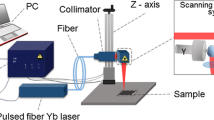Abstract
IN 1897, Russell1 discovered that freshly abraded metal surfaces produce an image on photographic plates and suggested that hydrogen peroxide is responsible for this action. Although a considerable amount of work was done on this subject in the first decade of this century, the only more recent publication is a paper by Churchill2. Work in the Mechanical Engineering Research Laboratories at Thorntonhall confirms that hydrogen peroxide is produced whenever fresh surfaces of certain metals are exposed to the action of water and oxygen. When, for example, aluminium, magnesium, nickel or zinc is cut under water, measurable quantities of hydrogen peroxide are produced3.
Similar content being viewed by others
References
Russell, W. J., Proc. Roy. Soc., 61, 424 (1897); 63, 102 (1898); 64, 409 (1899); 78, 385 (1906); 80, 376 (1908).
Churchill, J. R., Trans. Electrochem. Soc., 76, 341 (1939).
Grunberg, L. (to be published).
Kramer, J., “Der Metallische Zustand” (Göttingen, 1950); Z. Phys., 125, 739 (1949); 128, 538 (1950); 129, 34 (1951).
Author information
Authors and Affiliations
Rights and permissions
About this article
Cite this article
GRUNBERG, L., WRIGHT, K. Russell Effect on Evaporated Metal Films. Nature 170, 456–457 (1952). https://doi.org/10.1038/170456b0
Issue Date:
DOI: https://doi.org/10.1038/170456b0
- Springer Nature Limited
This article is cited by
-
Das R�tsel der Exoelektronen Historie, gegenw�rtiger Stand, L�sungsvorschl�ge
Naturwissenschaften (1977)
-
An Autoradiographic Effect
Nature (1961)
-
A Possible Origin of Exo-Electron Emission in Plastically Deformed Metals
Nature (1960)
-
Crystal Defects in Freshly Worked Surfaces
Nature (1954)
-
Kramer and Russell Effects with Single Crystals of Zinc
Nature (1953)




